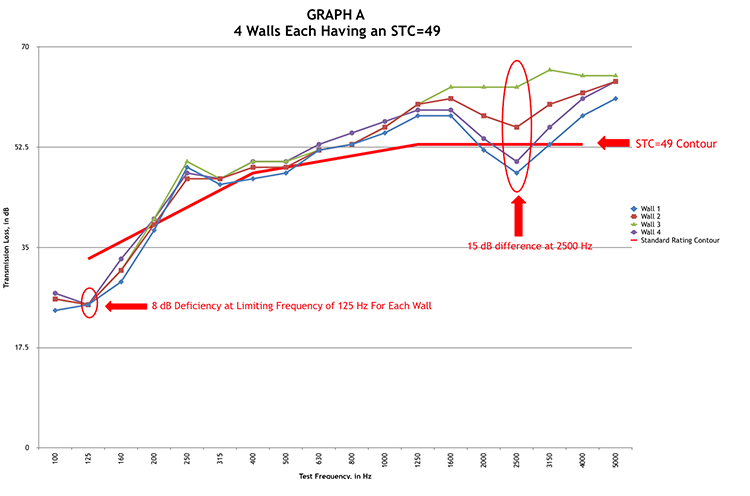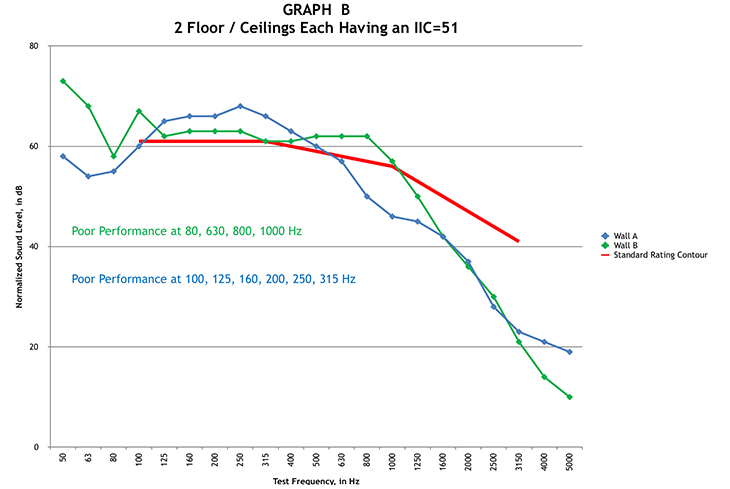Acoustical Testing
What Acoustic Single Number Ratings Do and Don't Tell You
You know the acronyms, but do you know what they really say?
Understanding Acoustic Single Number Ratings
An acoustic single number rating is a yardstick by which the acoustical performance of materials and systems is evaluated and compared to others. Examples include:
- Sound Transmission Class (STC)
- Impact Insulation Class (IIC)
- Outdoor-Indoor Transmission Class (OITC)
- Noise Reduction Coefficient (NRC)
- Ceiling Attenuation Class (CAC)
A single number rating is arrived at by fitting data that has been measured during the tests to that of standard rating contours. The contours of these standard curves are used to predict the acceptability of transmitted sound to the response of human hearing.
Measured accurately and in strict accordance with precise ASTM test standards, the testing data is used by architects, consultants, and builders to design and build assemblies that meet code requirements or address occupancy needs for buildings such as schools or apartments.
Limitations of Acoustic Single Number Ratings
Are the single number ratings in and of themselves adequate to predict how the material and system being installed will perform? Not always.
To predict the performance that a material or system will acoustically provide requires not only the single number rating but also the performance of the material or system at each frequency measurement at which they are made during a test. This information is used to arrive at the single-number rating by fitting the measured data to and shifting the standard rating contour.
Acoustical tests measure in the frequency range of 80 Hertz to 5000 Hertz, which is the primary frequency range of human hearing. An acoustical consultant will analyze the attenuation, insulation, or absorption of a material or system at each frequency to accurately predict how well it will perform when installed in the field.
Application-Specific Considerations
Does an STC of 50 mean that a wall will reduce noise by 50 decibels (dB) from one room to another? Not necessarily. Will walls having the same STC be acoustically equivalent in the field? Not necessarily.
It all depends on the frequency content of the noise source and the performance of the material or system at each frequency.
Graph A illustrates four walls all having an STC rating of 49, but there are up to 15-dB differences at the individual higher frequencies.

Graph B illustrates two floor-ceiling assemblies, each with an IIC rating of 51, but there are significant differences in their performance at several frequencies.

The Importance of Comprehensive Acoustic Testing
In the world of acoustics, the importance of comprehensive testing cannot be overstated. While acoustic single number ratings provide a quick snapshot of a material or structure's acoustic performance, they often fall short in capturing the full complexity of real-world scenarios.
On the other hand, comprehensive acoustic testing goes beyond the limitations of acoustic single number ratings, offering a holistic understanding of how sound interacts with the built environment.
Learn more about why comprehensive acoustic testing is crucial for achieving optimal acoustic environments:
- Comprehensive testing takes into account the diversity of real-world conditions. A room's size, shape, and purpose can significantly impact its acoustic properties. Unlike theoretical calculations, field tests provide accurate insights into how sound behaves in specific environments.
- Acoustic performance isn't uniform across all frequencies. Comprehensive testing includes a detailed analysis of the frequency response, allowing for tailored solutions that address specific frequency ranges, ensuring a more balanced and effective acoustic design.
- Many industries and applications have specific acoustic standards and regulations that must be met. Comprehensive testing ensures that your project not only meets but exceeds these requirements, providing confidence in the acoustic performance of your structures.
- Achieving the perfect balance between aesthetics and acoustics requires a nuanced approach. Comprehensive testing allows for fine-tuning acoustic solutions that seamlessly integrate with the design, enhancing the overall user experience.
Partner With NGC Testing Services for Comprehensive Acoustical Testing
When it comes to acoustical testing, single number ratings do not tell the whole story in many cases. Depending on the noise source, the results at individual frequencies will better predict the performance of an acoustical assembly or material.
For projects where precision, compliance, and long-term success are paramount, investing in comprehensive acoustic testing is not just advisable — it's essential.
Looking for an acoustical testing provider with decades of experience, full-scale facilities, and quick turnaround times? NGC Testing Services is the best in test. Reach out to our team today to learn more about our acoustical testing services.
This post was originally published in September 2021 by Bob Menchetti and was updated and republished in February 2024.
Search blog articles
Browse by topic
Subscribe for updates
LEARN MORE
Related Blog Articles
GET IN TOUCH
Contact Us
NGC Testing Services features one of North America's most comprehensive and unique fully accredited testing facilities. Contact us today to visit our 50,000-plus-square-foot facility located in Buffalo, New York.

